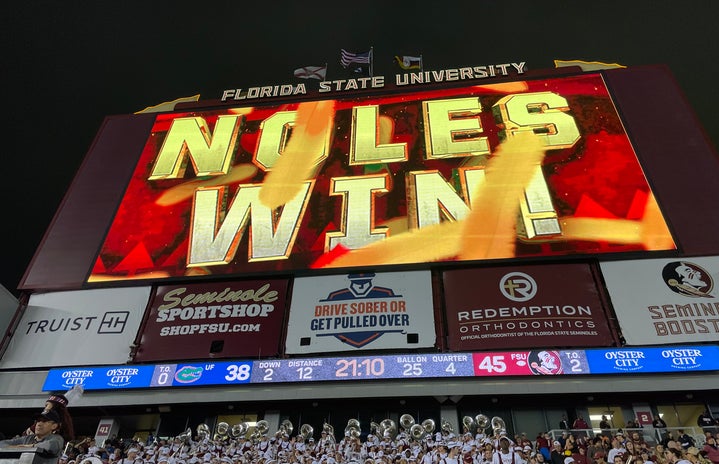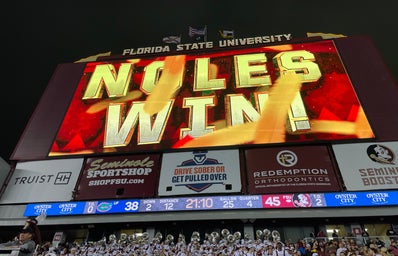Florida State University (FSU) football is back! Our season has started with a bang and it looks like our team is only going up from here. When I first came to college, I was lost with the rules of football. I would go to the games ready to cheer on the team but could only recognize the touchdowns.
First downs? Field goals? Why are we cheering in this moment? What is this song? Why does the other team have the ball? I would sit in the stands lost as to what was going on, wishing that someone could sit me down and give me the FSU football handbook. Knowing the sport itself is important, but our FSU football traditions hold a strong importance of their own. Lost about what’s happening at the games? Look no further than this article for the 411 on all things Florida State football.
Who are the key players in a football game?
Each team is made up of 11 players on the field at a time, each with a unique specialty and goal, but for the purpose of this article, I’ll be looking at what I deem to be the three most important positions: quarterback (QB), running back (RB), and wide receiver (WR). Our main quarterback is Jordan Travis, and his main purpose is to pass the ball and make the most critical in-game decisions. The quarterback is easily the most recognizable person on a football team. Trey Benson is our running back, and the main focus of his position is to gain yards on the field to get closer to scoring. Our main wide receiver is Keon Coleman — you’ll be hearing his name a lot this season. His main duty on the field is to catch the passes from the quarterback. With these three individuals playing together, FSU is a powerhouse.
How do we score?
Our first two games of the season against Louisiana State University (LSU) and the University of Southern Mississippi were great wins from Florida State, but how did we get those scores? The answer is touchdowns. When we successfully moved the ball from its starting point to the endzone, we scored a touchdown, gaining six points for our team. Following the touchdown, we had the opportunity to kick for a field goal. If the team makes the ball between the goalposts, it gets one extra point. Together, this creates the typical seven points that add together for the average total touchdown score. If we aren’t sure we can make a touchdown, we can choose to make a field goal on our fourth down, and that would add three points instead. Obviously, the goal is a touchdown, but in a close game or when making it to the endzone seems impossible, a field goal kick is a great choice.
What the heck is a “down?”
Let me back up for a second. Teams go back and forth with control of the ball in an attempt to score. During that turn with the ball (also known as a play), each team is allowed four downs (or attempts) to move the ball. Downs are 10 yards each, which means every time the team moves 10 yards down the field, they get a first down, and we get four more attempts (downs) to get to the endzone where we score. It sounds slightly confusing in writing, but at the next home game, you’ll hear the crowd cheer, “Let’s hear it for another Florida State first down,” and you’ll be able to recognize what has just happened.
more terms to keep in mind
What I just encapsulated are the basics of the game: the players, how we score, and what the points mean. But there is much more to college football and its rules. Another key term to look out for is when a flag is thrown: that is the referee signaling that a penalty may have occurred during the play. A penalty is essentially a rule break and results in an advantage for the team that was affected by the malpractice. An interception is when the opposing team obtains the ball mid-play. For example, this occurred during the LSU game, when FSU obtained the ball while it was in LSU’s possession and was then able to score. This act of switching ball possession is called a turnover.
FSU Football culture
Another aspect of FSU football culture, and my favorite, is the spirit that comes at the games through our amazing band, the Marching Chiefs. There are a few repeating melodies and traditions throughout the game, so let’s break those down.
When we are playing defense (trying to stop the other team from scoring), you will often hear the Chiefs play the war chant. It is a rule during football that the band cannot play when the ball is in motion, but often the Chiefs will prime the crowd with the war chant so that the sounds of our cheers echo as the teams begin to play. Every time we score a touchdown, you’ll hear the FSU Fight Song, and a snippet of it is also played every time we get a first down. These musical sounds of encouragement are a staple within Florida State tradition.
A couple of other mid-game callouts to know include when we reach the fourth quarter, the band will play the song “The Good, The Bad, and The Ugly,” and the crowd holds up four fingers to signify the beginning of this final quarter. As mentioned earlier, the announcer also delivers a cheer during home games every time the team achieves a first down.
We are looking to have an exciting football season this year. We have an incredibly talented team, along with a passionate fanbase who is ready to support them. So go on out to these football teams and support the Noles! While you’re there, don’t forget these rules, tips, and tricks to show off your football knowledge.
Want to see more HCFSU? Be sure to like us on Facebook and follow us on Instagram, Twitter, TikTok, and Pinterest!


